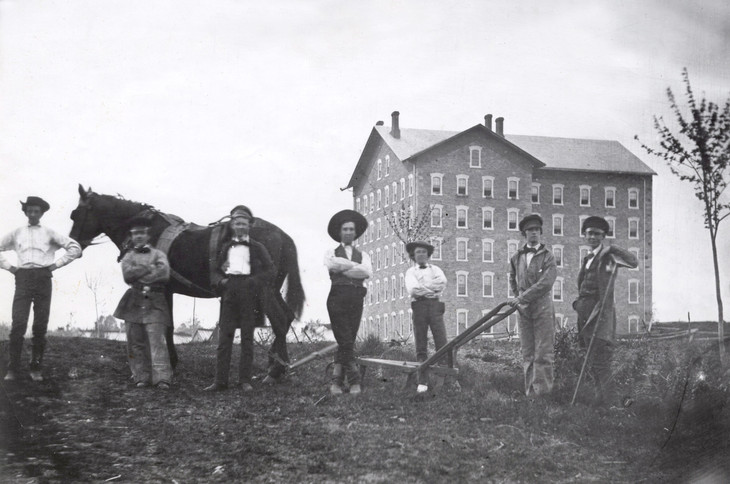Every year since 2014, and thirty-seven times in each program’s history, Penn State has squared off against Michigan State on the gridiron. When Penn State joined the Big Ten in 1993, Michigan State was designated as the Nittany Lions’ permanent rival, and a trophy was created. The Land-Grant Trophy has seen some fierce battles among legendary players and coaches, with Penn State triumphant again in 2023. While the game remains a highlight on the calendar, its trophy namesake—the Morrill Land-Grant Act—is largely unknown by the thousands of spectators who enjoy the annual matchup.
The desire to create colleges for the “working class” traces its roots to the 1830s, when visionary Johnathan Baldwin Turner began exploring ideas of universal education, regardless of background. Culminating in his 1850 speech at the Illinois Teaching Institute entitled “A Plan of our State University for the Industrial Class,” Turner outlined core principles that would become tenets for supporters of agricultural education. This moment marked a pivotal shift in education. States across the U.S. began petitioning Congress to make grants for public lands to be used in the creation of agricultural schools.
In 1857, the first bill pertaining to these “land grants” was introduced in Congress, influenced by Turner’s now nationally famous papers on the topic. Justin Morrill, a forty-seven-year-old Vermont representative in his first term in the U.S. House of Representatives, was entrusted to bring the bill to the floor, having proven himself a staunch supporter of agricultural interests.
The 1857 bill failed to make it out of committee in the House. A year later, the bill was reintroduced, only to fail on the House floor. It was introduced again several months later, passing through the House, only to fail on the Senate floor. Each iteration of the bill maintained the spirit of Turner’s original ideas, while compromising to secure necessary votes. Finally, in 1859, the Morrill Act passed both the House and Senate with considerable support on both sides of the aisle … but was vetoed by President James Buchanan. Then, in the midst of the Civil War, the 1862 Morrill Land-Grant Act cruised through Congress, landing on the desk of President Abraham Lincoln, who was eager to sign the bill.
The Morrill Land-Grant Act aimed to use profits from the sale of public lands to corporations, railroads, and individuals to fund agricultural and technical education in America. As America expanded, so did the revenue at the governments’ disposal. Schools across the country vied for access to the funds, as the bill only allotted funds for one agricultural school per state. The new Farmer’s High School, founded in 1855 on 200 acres of donated land in central Pennsylvania, faced a difficult battle to become Pennsylvania’s land-grant institution.
From the time of its founding, the Farmer’s High School aimed to provide an agricultural education to the students of Pennsylvania. Under the stewardship of first President Evan Pugh, the campus evolved, introducing new subjects and a service-oriented mission. Students would learn in traditional classrooms similar to those in traditional colleges, but would then practice applications using farming equipment, tending to livestock, and maintaining school grounds. As the popularity of the Morrill Land-Grant bills grew throughout the late 1850s and early 1860s, Pugh looked to position the school to access the funds. One major step, taken in 1862, saw Pugh rebrand the Farmer’s High School as the Agricultural College of Pennsylvania to better align with the language of the bill, which promised funding for “colleges” and “universities” rather than “high schools.” Additionally, Pugh lobbied hard for the school, writing letters to influential lawmakers, lawyers, and judges expressing the importance of funding. To illustrate his point, Pugh needed to look no further than the unfinished “Main Building,” whose construction was halted in 1857 and again at the outset of the Civil War due to financial constraints.

The future Penn State was not the only school eligible for the grant money in Pennsylvania. Polytechnic College of the State of Pennsylvania, located outside Philadelphia, had renowned mechanical arts programs and was the favorite contender with the Philadelphia elite. The decision would come down to the Pennsylvania governor, who alone had the power to designate the recipient of the funds. In a move that would enrage schools across the state, Governor Andrew Curtin, a Bellefonte resident and trustee of the Agricultural College of Pennsylvania, named the former Farmer’s High School as Pennsylvania’s sole recipient of the Morrill Land-Grant money.
The battle to keep the funds, and later to keep the college’s doors open, would rage for the next several decades, until the leadership of George Atherton would stabilize the school. At its core, Penn State still stands true to its land-grant roots. Accessible education and public service are part of the mission, just as Johnathan Turner and Justin Morrill envisioned over 160 years ago. T&G
Local Historia is a passion for local history, community, and preservation. Its mission is to connect you with local history through engaging content and walking tours. Local Historia is owned by public historians Matt Maris and Dustin Elder, who co-author this column. For more, visit localhistoria.com.
Sources:
The Civil War: The Senate’s story. U.S. Senate: The Civil War: The Senate’s Story. (2023, August 8). https://www.senate.gov/artandhistory/history/common/civil_war/MorrillLandGrantCollegeAct_FeaturedDoc.htm#:~:text=First%20proposed%20when%20Morrill%20was,law%20on%20July%202%2C%201862.
Encyclopædia Britannica, inc. (2023, October 28). Pennsylvania State University. Encyclopædia Britannica. https://www.britannica.com/topic/Pennsylvania-State-University
Milestones in the history of LG Univ. – college of agricultural sciences. (n.d.). https://cropandsoil.oregonstate.edu/sites/agscid7/files/land-grant_0.pdf
Origins: The land-grant vision. Penn State University Libraries. (2020, June 3). https://libraries.psu.edu/about/collections/penn-state-university-park-campus-history-collection/penn-state-illustrated-0
Read “colleges of agriculture at the land grant universities: A profile” at nap.edu. History and Overview of the Land Grant College System | Colleges of Agriculture at the Land Grant Universities: A Profile | The National Academies Press. (n.d.). https://nap.nationalacademies.org/read/4980/chapter/2




